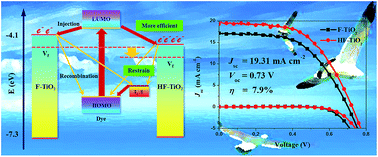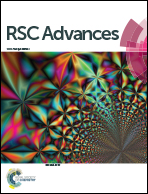Prolonged lifetime and retarded recombination in dye sensitized solar cells using hydrogenated fluorine doped TiO2 nanocrystals as a photoanode
Abstract
Hydrogenated fluorine doped anatase TiO2 nanoparticles (HF-TiO2) are synthesized using an annealing method and applied in dye-sensitized solar cells (DSSCs) as an excellent photoanode nanomaterial. An X-ray diffraction analysis (XRD) and X-ray photoelectron spectroscopy (XPS) were used to analyze the structure and chemical composition of the material. Scanning electron microscopy (SEM) was applied to characterize the morphology of HF-TiO2. UV-visible absorption spectroscopy (UV-vis), valence band analysis and Mott–Schottky plots were used to elucidate the electronic band structure. The results show that the HF-TiO2 samples can positively shift the conduction band of TiO2, thus enlarging the driving force for efficient electron injection, reducing the interfacial losses from charge recombination and consequently facilitating charge transfer. The conversion efficiency of DSSCs with HF-TiO2 electrodes is improved from 6.5% to 7.9% and results in a 20% photocurrent enhancement. This work provides a comprehensive explanation of the electronic structure and electron behaviors of HF-TiO2 samples in DSSCs, like the mechanism of electron injection, transfer and recombination, and a promising strategy to explore high efficiency DSSCs.


 Please wait while we load your content...
Please wait while we load your content...